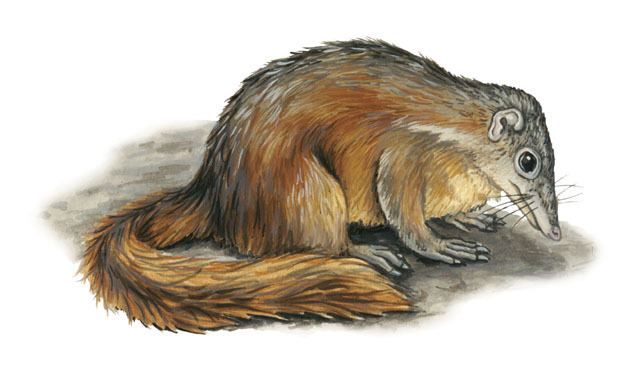Scientific name Tupaia tana | Phylum Chordata Order Scandentia Genus Tupaia Rank Species | |
 | ||
Similar Pygmy treeshrew, Tupaia, Slender treeshrew, Ruddy treeshrew, Striped treeshrew | ||
Mammals of the world large treeshrew
The large treeshrew (Tupaia tana) is a treeshrew species within the Tupaiidae. It is native to Sumatra and adjacent small islands, as well as in the lowlands and hills of Borneo.
Contents
Habitat
Large treeshrews are the most predominantly terrestrial of all treeshrew species. They are usually on the forest floor, the primary location for their foraging, although they spend part of their time in trees. T. tana has been described as mainly terrestrial based on field observations and their morphological traits. Large treeshrews are most abundant in primary tropical rainforest, but are also found in swamp forest and secondary growth forest. T. tana has many potential predators such as the marbled cat, leopard, and clouded leopard.
Large treeshrews contribute to maintenance of their lowland rainforest ecosystem by dispersing seeds.
Morphology, diet and reproduction
T. tana is slightly larger than the common treeshrew (T. glis). The dorsal fur is reddish brown, shading to nearly black at the rear. There is a black stripe running from the neck half to two thirds of the way down the back, until it disappears in the darker posterior fur. The distance from the center of the eye to the tip of the muzzle is more than 37 mm in adults. The body size measurements of this species are: head and body, 165–321 mm; tail, 130–220 mm; hind foot, 43–57 mm. The weight is 154-305 g. T. tana has sensitive hearing and large eyes that give it acute night vision but poor daylight vision.
Their diet consists of earthworms and arthropods such as centipedes, millipedes and beetle larvae, with some fruit. Less favored arthropods include ants, beetles, spiders, cockroaches and crickets.
The average age of reproductive maturity for both males and females is around one year of age. The female almost always gives birth to two altricial young. The fecundity of females is reduced in poor quality territories or during periods of resource scarcity.
